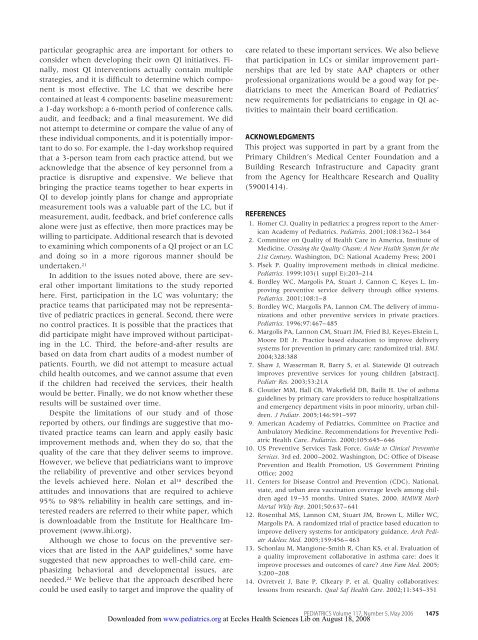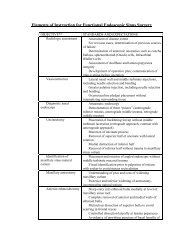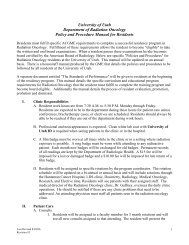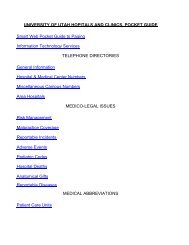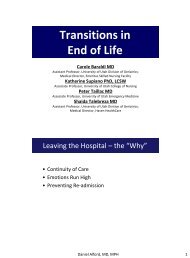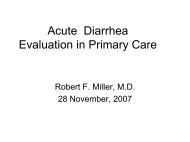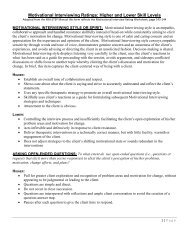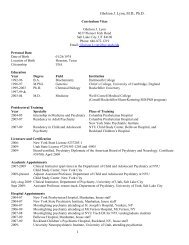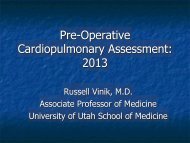Evaluation of a Learning Collaborative to Improve the Delivery of ...
Evaluation of a Learning Collaborative to Improve the Delivery of ...
Evaluation of a Learning Collaborative to Improve the Delivery of ...
Create successful ePaper yourself
Turn your PDF publications into a flip-book with our unique Google optimized e-Paper software.
particular geographic area are important for o<strong>the</strong>rs <strong>to</strong><br />
consider when developing <strong>the</strong>ir own QI initiatives. Finally,<br />
most QI interventions actually contain multiple<br />
strategies, and it is difficult <strong>to</strong> determine which component<br />
is most effective. The LC that we describe here<br />
contained at least 4 components: baseline measurement;<br />
a 1-day workshop; a 6-month period <strong>of</strong> conference calls,<br />
audit, and feedback; and a final measurement. We did<br />
not attempt <strong>to</strong> determine or compare <strong>the</strong> value <strong>of</strong> any <strong>of</strong><br />
<strong>the</strong>se individual components, and it is potentially important<br />
<strong>to</strong> do so. For example, <strong>the</strong> 1-day workshop required<br />
that a 3-person team from each practice attend, but we<br />
acknowledge that <strong>the</strong> absence <strong>of</strong> key personnel from a<br />
practice is disruptive and expensive. We believe that<br />
bringing <strong>the</strong> practice teams <strong>to</strong>ge<strong>the</strong>r <strong>to</strong> hear experts in<br />
QI <strong>to</strong> develop jointly plans for change and appropriate<br />
measurement <strong>to</strong>ols was a valuable part <strong>of</strong> <strong>the</strong> LC, but if<br />
measurement, audit, feedback, and brief conference calls<br />
alone were just as effective, <strong>the</strong>n more practices may be<br />
willing <strong>to</strong> participate. Additional research that is devoted<br />
<strong>to</strong> examining which components <strong>of</strong> a QI project or an LC<br />
and doing so in a more rigorous manner should be<br />
undertaken. 21<br />
In addition <strong>to</strong> <strong>the</strong> issues noted above, <strong>the</strong>re are several<br />
o<strong>the</strong>r important limitations <strong>to</strong> <strong>the</strong> study reported<br />
here. First, participation in <strong>the</strong> LC was voluntary; <strong>the</strong><br />
practice teams that participated may not be representative<br />
<strong>of</strong> pediatric practices in general. Second, <strong>the</strong>re were<br />
no control practices. It is possible that <strong>the</strong> practices that<br />
did participate might have improved without participating<br />
in <strong>the</strong> LC. Third, <strong>the</strong> before-and-after results are<br />
based on data from chart audits <strong>of</strong> a modest number <strong>of</strong><br />
patients. Fourth, we did not attempt <strong>to</strong> measure actual<br />
child health outcomes, and we cannot assume that even<br />
if <strong>the</strong> children had received <strong>the</strong> services, <strong>the</strong>ir health<br />
would be better. Finally, we do not know whe<strong>the</strong>r <strong>the</strong>se<br />
results will be sustained over time.<br />
Despite <strong>the</strong> limitations <strong>of</strong> our study and <strong>of</strong> those<br />
reported by o<strong>the</strong>rs, our findings are suggestive that motivated<br />
practice teams can learn and apply easily basic<br />
improvement methods and, when <strong>the</strong>y do so, that <strong>the</strong><br />
quality <strong>of</strong> <strong>the</strong> care that <strong>the</strong>y deliver seems <strong>to</strong> improve.<br />
However, we believe that pediatricians want <strong>to</strong> improve<br />
<strong>the</strong> reliability <strong>of</strong> preventive and o<strong>the</strong>r services beyond<br />
<strong>the</strong> levels achieved here. Nolan et al 18 described <strong>the</strong><br />
attitudes and innovations that are required <strong>to</strong> achieve<br />
95% <strong>to</strong> 98% reliability in health care settings, and interested<br />
readers are referred <strong>to</strong> <strong>the</strong>ir white paper, which<br />
is downloadable from <strong>the</strong> Institute for Healthcare <strong>Improve</strong>ment<br />
(www.ihi.org).<br />
Although we chose <strong>to</strong> focus on <strong>the</strong> preventive services<br />
that are listed in <strong>the</strong> AAP guidelines, 9 some have<br />
suggested that new approaches <strong>to</strong> well-child care, emphasizing<br />
behavioral and developmental issues, are<br />
needed. 22 We believe that <strong>the</strong> approach described here<br />
could be used easily <strong>to</strong> target and improve <strong>the</strong> quality <strong>of</strong><br />
care related <strong>to</strong> <strong>the</strong>se important services. We also believe<br />
that participation in LCs or similar improvement partnerships<br />
that are led by state AAP chapters or o<strong>the</strong>r<br />
pr<strong>of</strong>essional organizations would be a good way for pediatricians<br />
<strong>to</strong> meet <strong>the</strong> American Board <strong>of</strong> Pediatrics’<br />
new requirements for pediatricians <strong>to</strong> engage in QI activities<br />
<strong>to</strong> maintain <strong>the</strong>ir board certification.<br />
ACKNOWLEDGMENTS<br />
This project was supported in part by a grant from <strong>the</strong><br />
Primary Children’s Medical Center Foundation and a<br />
Building Research Infrastructure and Capacity grant<br />
from <strong>the</strong> Agency for Healthcare Research and Quality<br />
(59001414).<br />
REFERENCES<br />
1. Homer CJ. Quality in pediatrics: a progress report <strong>to</strong> <strong>the</strong> American<br />
Academy <strong>of</strong> Pediatrics. Pediatrics. 2001;108:1362–1364<br />
2. Committee on Quality <strong>of</strong> Health Care in America, Institute <strong>of</strong><br />
Medicine. Crossing <strong>the</strong> Quality Chasm: A New Health System for <strong>the</strong><br />
21st Century. Washing<strong>to</strong>n, DC: National Academy Press; 2001<br />
3. Plsek P. Quality improvement methods in clinical medicine.<br />
Pediatrics. 1999;103(1 suppl E):203–214<br />
4. Bordley WC, Margolis PA, Stuart J, Cannon C, Keyes L. Improving<br />
preventive service delivery through <strong>of</strong>fice systems.<br />
Pediatrics. 2001;108:1–8<br />
5. Bordley WC, Margolis PA, Lannon CM. The delivery <strong>of</strong> immunizations<br />
and o<strong>the</strong>r preventive services in private practices.<br />
Pediatrics. 1996;97:467–485<br />
6. Margolis PA, Lannon CM, Stuart JM, Fried BJ, Keyes-Elstein L,<br />
Moore DE Jr. Practice based education <strong>to</strong> improve delivery<br />
systems for prevention in primary care: randomized trial. BMJ.<br />
2004;328:388<br />
7. Shaw J, Wasserman R, Barry S, et al. Statewide QI outreach<br />
improves preventive services for young children [abstract].<br />
Pediatr Res. 2003;53:21A<br />
8. Cloutier MM, Hall CB, Wakefield DB, Bailit H. Use <strong>of</strong> asthma<br />
guidelines by primary care providers <strong>to</strong> reduce hospitalizations<br />
and emergency department visits in poor minority, urban children.<br />
J Pediatr. 2005;146:591–597<br />
9. American Academy <strong>of</strong> Pediatrics, Committee on Practice and<br />
Ambula<strong>to</strong>ry Medicine. Recommendations for Preventive Pediatric<br />
Health Care. Pediatrics. 2000;105:645–646<br />
10. US Preventive Services Task Force. Guide <strong>to</strong> Clinical Preventive<br />
Services. 3rd ed. 2000–2002. Washing<strong>to</strong>n, DC: Office <strong>of</strong> Disease<br />
Prevention and Health Promotion, US Government Printing<br />
Office; 2002<br />
11. Centers for Disease Control and Prevention (CDC). National,<br />
state, and urban area vaccination coverage levels among children<br />
aged 19–35 months. United States, 2000. MMWR Morb<br />
Mortal Wkly Rep. 2001;50:637–641<br />
12. Rosenthal MS, Lannon CM, Stuart JM, Brown L, Miller WC,<br />
Margolis PA. A randomized trial <strong>of</strong> practice based education <strong>to</strong><br />
improve delivery systems for anticipa<strong>to</strong>ry guidance. Arch Pediatr<br />
Adolesc Med. 2005;159:456–463<br />
13. Schonlau M, Mangione-Smith R, Chan KS, et al. <strong>Evaluation</strong> <strong>of</strong><br />
a quality improvement collaborative in asthma care: does it<br />
improve processes and outcomes <strong>of</strong> care? Ann Fam Med. 2005;<br />
3:200–208<br />
14. Ovretveit J, Bate P, Clkeary P, et al. Quality collaboratives:<br />
lessons from research. Qual Saf Health Care. 2002;11:345–351<br />
PEDIATRICS Volume 117, Number 5, May 2006 1475<br />
Downloaded from<br />
www.pediatrics.org at Eccles Health Sciences Lib on August 18, 2008


